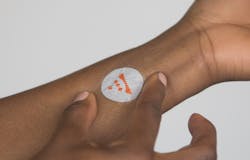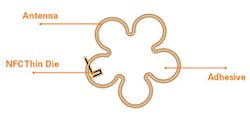Electronic Tattoos for Healthcare Shift to Gather Business Data
Ben Schlatka maintains that the company he helped found is focused on healthcare. As vice president of corporate development at wearable healthcare startup MC10, he helped supervise the release of the company’s first product, BioStamp, an electronic skin patch filled with advanced sensors that record and transmit data about a person’s muscle activity and nerve health.
But another feature of the electronic patch has enticed industries far outside healthcare. The Massachusetts-based company builds extremely thin and flexible electronics that mimic human skin. These can be glued directly onto the skin and, using a smartphone or other device, transmit data into the cloud. The information is meant to be accessed by doctors and researchers, or analyzed by software programs.
Now, MC10 is turning its healthcare technology over to businesses looking to create new experiences for their customers and exploit new methods for gathering data. The company recently licensed one of its products, an electronic patch that resembles a temporary tattoo, to the manufacturing consulting firm PCH.
The “electronic tattoo” is a combination of advanced polymers and stretchable metal interconnects known as the Wearable Interactive Stamp Platform, or WiSP. No larger than a postage stamp and as thin as a human hair, these devices consist of an antenna and thinned near-field communication chip mounted onto a stretchable adhesive. The device is passive and sends data through NFC-enabled smartphones or readers into the cloud.
In healthcare, WiSP devices are intended to complement more sophisticated medical sensors, storing "a single piece of information that could be read episodically," Schlatka said in a phone interview. The WiSP devices that MC10 has built itself contain sensors that capture electrocardiograms and logged heart rates in real time.
While the Biostamp can be recharged and reused, WiSP devices are low-cost and disposable, Andre Yousefi, co-founder of Lime Lab, the design engineering division of PCH, said in an e-mail. The electronic tattoos could be handed out instead of tickets at a concert or paired with a smartphone to let people make payments with the patch on the back of their hand. PCH is “already in discussions with several major brands in these categories," he added.
Businesses can also build custom sensors into the devices and program the NFC chip to perform different tasks, like give someone backstage access at a concert. "Our partnership with MC10 opens the door for other brands to develop consumer applications using this unique wearable platform. The stamp is highly customizable, allowing brands to create personalized and engaging experiences," Liam Casey, chief executive of PCH, said in a statement.
The possibilities for WiSP underline the increasingly porous boundaries between healthcare, consumer electronics, and businesses now that everything seems ripe for data mining. Most wearables have skirted around healthcare by making devices that collect data on personal fitness. These fitness trackers have inspired a new kinds of smart bracelets, like Disney’s MagicBand, which allows guests at Disney World to access parks and make contactless payments.
The first commercial products based on the "smart stamp" were stretchable sensors designed by L'Oreal to monitor exposure to ultraviolet light. The My UV Patch, which was revealed earlier this year at the Consumer Electronics Show, contains dyes that conform to a person’s skin tone and react to sunlight. Take a picture of the patch or wave your smartphone over it, and a mobile app determines how badly your skin has been exposed.
PCH has floated other ideas about the technology's potential. Guests at an amusement park, for instance, could wear WiSP devices programmed to allow access to the rides and to other attractions. Credit-card information could also be uploaded to the chip, which provides 32-bit data protection, so that people could buy food or souvenirs by waving the patch over a terminal. The stamps can be glued onto skin for up to two days and when guests leave the park, they peel off the device and it can no longer be read. The amusement park could use the data gathered by WiSP to track the flow of guests and what they used their patches for.
In the meantime, MC10 is keeping its roots in healthcare. John Rogers, a material scientist from the University of Illinois, helped found the company as an outlet for flexible electronics research in 2008. And his research is still focused on healthcare devices such as flexible sensor circuits that can be wrapped around the human heart and pressure sensors that can be implanted in the skull to monitor brain trauma.
While these sensors are not likely to help people get into concerts or make mobile payments, they underline the unique changes in how we interact with electronics. “The goal is really to blur the distinction between man-made electronic systems and biology,” Rogers said.
About the Author
James Morra
Senior Editor
James Morra is the senior editor for Electronic Design, covering the semiconductor industry and new technology trends, with a focus on power electronics and power management. He also reports on the business behind electrical engineering, including the electronics supply chain. He joined Electronic Design in 2015 and is based in Chicago, Illinois.


